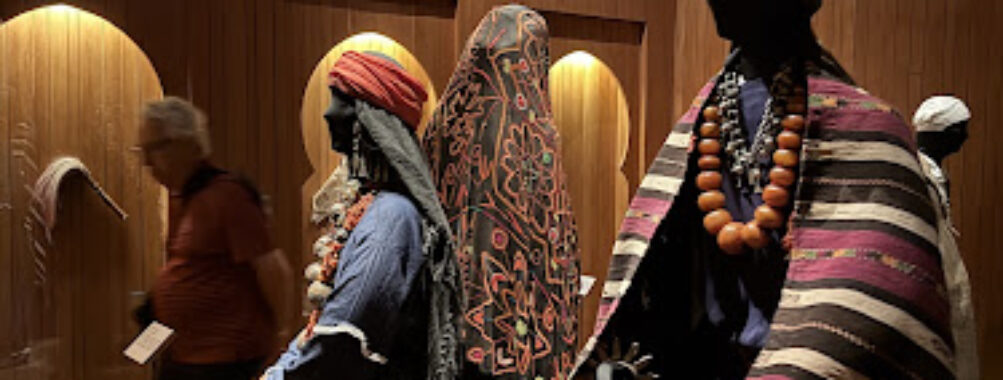
Musée Berbère Jardin Majorelle
Table of Contents
Description
The Musée Berbère inside the Jardin Majorelle is one of those places that quietly surprises you. Tucked away in what was once Jacques Majorelle’s painting studio, it now holds a collection that shines a light on the Berber (or Amazigh) people—North Africa’s oldest cultural group. The museum isn’t overwhelming in size, but that’s part of its charm. It feels intimate, almost like stepping into someone’s private collection, except that the objects on display—over 600 of them—are extraordinary. From centuries-old jewelry to richly embroidered clothing and everyday tools, you get a sense of how deeply creativity and craftsmanship are woven into Berber life.
Walking through the galleries, you’ll notice the curation is thoughtful. Each section tells a different story, whether it’s about the symbolism behind intricate silver ornaments or the practical beauty of woven textiles. I remember pausing at a display of musical instruments, and honestly, I could almost hear the rhythms of desert festivals in my head. It’s not just about looking at artifacts—it’s a glimpse into a living culture that continues to shape Morocco today. Some visitors might find the museum smaller than expected, but for many, that compactness makes it more digestible and personal. And if you’re already wandering through the lush gardens outside, stepping into the museum adds a layer of depth to the whole experience.
Key Features
- Collection of over 600 authentic Berber artifacts, from jewelry to textiles
- Former art studio of Jacques Majorelle, repurposed into a cultural space
- Displays of traditional costumes, tools, and musical instruments
- Wheelchair accessible entrance and restrooms
- Family-friendly atmosphere with discounts for children
- Restrooms and Wi-Fi available on-site
- Curated by Pierre Bergé and Yves Saint Laurent, who preserved the collection
Best Time to Visit
If you’ve been to Marrakech before, you know the city can be intense with its heat and crowds. The best time to wander into the Berber Museum is either in the morning or late afternoon, when the foot traffic is lighter and the air is cooler. Spring and autumn are generally the sweet spots for weather—warm but not sweltering, perfect for strolling the gardens before or after your museum visit. Summer afternoons can feel heavy, and while the museum is air-conditioned, you’ll probably enjoy it more when you’re not rushing to escape the heat. Personally, I loved visiting on a weekday morning; it felt calm, almost meditative, and I could linger at each display without feeling rushed.
How to Get There
The museum is located inside the famous Jardin Majorelle, which is one of Marrakech’s most visited attractions. If you’re staying near the Medina, a short taxi ride will get you there in under 15 minutes—though traffic in Marrakech has a mind of its own, so give yourself a little buffer. Some travelers enjoy walking from the Medina, but it can be a long, hot trek depending on the season. For convenience, I’d recommend a taxi or even a ride-hailing app if you’re not in the mood to haggle. Once you arrive at the garden entrance, the museum is just a short walk inside, clearly signposted. Tickets are usually purchased at the same time as your garden entry, and it’s smart to book them in advance since both the garden and museum are popular.
Tips for Visiting
Here are a few things I wish I’d known before going:
- Buy tickets ahead of time: The lines at Jardin Majorelle can be long, and the museum is included in many combo tickets. Booking early saves you the stress.
- Plan for crowds: This isn’t a hidden gem anymore, so expect other travelers. Early mornings are your best friend if you want some peace.
- Slow down: The museum is small, but don’t rush. Take your time reading the displays—it’s easy to breeze through, but the details are what make it special.
- Good for kids: Children often enjoy the colorful costumes and shiny jewelry. Plus, discounts for kids make it easier for families.
- No restaurant inside: There’s no café in the museum itself, so grab a bite before or after your visit. There are plenty of places nearby.
- Photography rules: Be mindful—many museums in Morocco restrict photography inside. Check signs or ask staff before snapping away.
- Accessibility: Wheelchair users will find accessible entrances and restrooms, which isn’t always the case in Marrakech attractions.
And one last personal note: don’t underestimate how moving it can be to see the artistry of everyday objects. I left with a deeper respect for Berber traditions, and honestly, it made me look differently at the handmade goods in the souks afterward. If you’re the kind of traveler who loves to connect with culture on a deeper level, this museum is worth carving out an hour or two of your itinerary.
Location
Places to Stay Near Musée Berbère Jardin Majorelle
Find and Book a Tour
Explore More Travel Guides
No reviews found! Be the first to review!